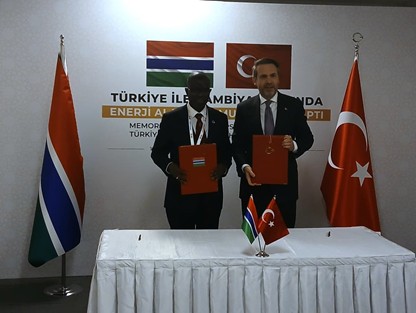Gambia and Türkiye build credible energy alliance
Gambia–Türkiye deal targets lower power costs and steadier external balances as BZ=F volatility eases; credible milestones could support GMD=X stability and nudge local mid-teen yields lower on reduced quasi-fiscal risk.

The 20 October 2025 energy cooperation agreement between The Gambia and Türkiye signals a pivot from emergency generation to bankable power infrastructure with measurable macro effects. Using calendar-year baselines, The Gambia’s GDP in 2024 was about USD 2.77 billion, real growth averaged roughly 5–6%, and average CPI inflation was in the mid-teens after a 2023 spike. General government debt stood near 73.5% of GDP in 2024 and the current-account deficit narrowed toward the low single digits. By translating a lease-heavy system into owned or long-tenor assets, the deal targets unit-cost reduction, reliability, and quasi-fiscal repair—preconditions for durable disinflation and lower local funding costs.
The policy mechanism is input substitution and system integration. Diesel-dominant generation has produced levelised costs above USD 0.30/kWh, overwhelming the utility’s balance sheet and constraining industrial output. The cooperation framework envisages LNG or dual-fuel capacity combined with grid reinforcements and operational support. On the physical baseline, installed capacity was documented at about 154.5 MW with roughly 97 MW available as of mid-2021; since then, import capability has expanded via the 225-kV OMVG interconnection, enabling higher cross-border supply into the Greater Banjul Area. The transition pathway therefore couples incremental domestic capacity with firm regional imports, reducing outage frequency and volatility in delivered power.
The macro transmission operates through three quantifiable channels. First, fuel-mix optimisation lowers the import bill and stabilises the current account. A USD 0.10/kWh reduction applied to the existing load would save on the order of USD 30–40 million per year—about 1–1.5% of 2024 GDP—subject to utilisation and LNG contract terms. Second, narrowing utility losses reduces the public-sector borrowing requirement, which in recent years has been pressured by 2–3% of GDP in quasi-fiscal gaps. That tightening supports debt-stabilising primary balances and extends the duration investors are willing to hold at auction. Third, reliability lifts non-tourism tradables and SME cash flows, raising investment efficiency and moderating pass-through to core goods and services. With the policy rate in restrictive territory and the dalasi (GMD=X) broadly stable in 2025, cost-side disinflation from power would allow gradual normalisation without undermining currency credibility.
Regional and global context strengthen the thesis. West Africa’s power market is moving toward deeper cross-border trading, and The Gambia’s interconnection aligns with ECOWAS objectives that favour capacity pooling and seasonal swaps. Türkiye’s export-credit-backed contractors provide a scalable template for small systems: bundled EPC, O&M, and financing that shorten construction schedules while embedding accountability through performance contracts. In global markets, energy-linked reforms in frontier credits have historically compressed local-currency yields when credible milestones, audited dispatch data, and tariff reforms coincided; oil benchmarks such as Brent (BZ=F) remain an external swing factor, but reduced diesel dependence lessens direct exposure to price spikes.
Market response will track delivery and disclosure. A credible commissioning schedule through 2026, published outage and load-factor statistics, and quarterly utility financials are necessary to translate engineering gains into tighter risk premiums. Domestic two- to three-year treasury yields remain in the mid-teens; each percentage-point improvement in the utility’s EBITDA margin lowers fiscal transfer risks and supports a modest decline in auction cut-offs as rollover anxiety eases. To guard against currency mismatches, power-purchase agreements and fuel contracts should incorporate hedging or local-currency indexation where feasible, while the debt office sequences external disbursements with reserve-adequacy targets.
Execution risk is concentrated in three areas: tariff calibration, fuel logistics, and governance. Tariffs must progress toward cost reflectivity with lifeline protection to sustain collection rates and cash recovery. LNG logistics—storage, regasification access, scheduling—must be in place ahead of commissioning to avoid stranded capacity and demurrage costs. Procurement and audit transparency will determine investor confidence; weak disclosure would keep the sovereign’s local curve elevated despite physical progress.
The forward test is explicit, dated, and measurable. By Q4-2026, firm supply (domestic and contracted imports) should consistently exceed peak demand with a reduction in system-average outage duration of at least 30% versus the 2024 baseline. By end-2027, average generation cost should fall toward USD 0.20/kWh, with utility losses reduced to below 1.5% of GDP and cash collection above 90%. By 2028, the current-account deficit should trend below 4% of GDP with reserves maintained at prudent coverage. Meeting these thresholds would confirm that the Gambia–Türkiye partnership has tightened the energy-fiscal loop, stabilised prices, and lowered local funding costs; failure would leave the economy exposed to diesel price volatility and balance-sheet drift.





